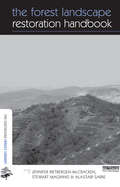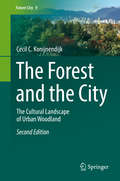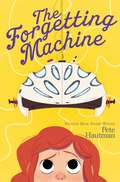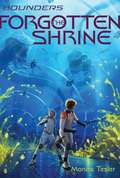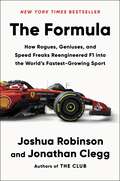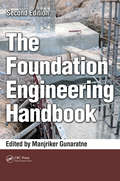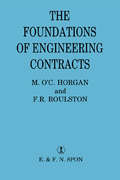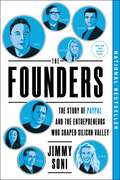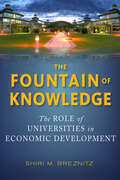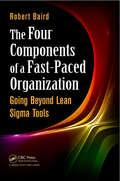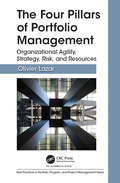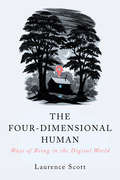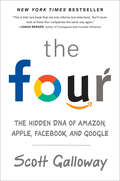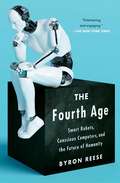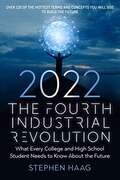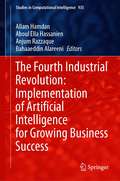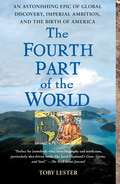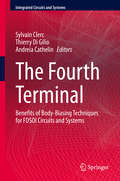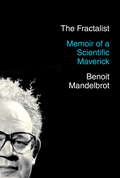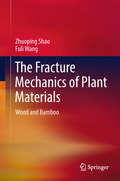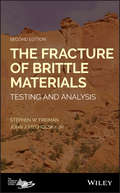- Table View
- List View
The Forest Landscape Restoration Handbook (The\earthscan Forest Library)
by Stewart Maginnis Jennifer Rietbergen-McCracken Alastair SarreForest loss and degradation have caused a decline in the quality of ecosystem services around the world. But fixing the problem takes more than just planting trees; practitioners increasingly realize that a landscape approach is essential. This handbook, authored and edited by international authorities in the field of forestry, is the first practical guide to using forest landscape restoration (FLR) to repair the damage done to forest lands by poor land management practice. Using research backed by respected institutions such as ITTO and the World Conservation Union (IUCN), it explains how to increase the resilience of landscapes and the communities they support through FLR. The main aim of FLR is not to re-establish pristine forest, even if this were possible; rather, the objective is to make landscapes more resilient and thereby keep future management options open. It also aims to support communities as they strive to increase and sustain the benefits they derive from land management. This book explains the concept of FLR and guides the reader through the steps that must be taken to put it into practice. It is an indispensable aid for practitioners in all aspects of forestry and natural resource management.
The Forest and the City: The Cultural Landscape Of Urban Woodland
by Cecil C. KonijnendijkAmsterdamse Bos, Bois de Boulognes, Epping Forest, Hong Kong’s country parks, Stanley Park: throughout history cities across the world have developed close relationships with nearby woodland areas. In some cases, cities have even developed – and in some cases are promoting – a distinct ‘forest identity’. This book introduces the rich heritage of these city forests as cultural landscapes, and shows that cities and forests can be mutually beneficial.Essential reading for students and researchers interested in urban sustainability and urban forestry, this book also has much wider appeal. For with city forests playing an increasingly important role in local government sustainability programs, it provides an important reference for those involved in urban planning and decision making, public affairs and administration, and even public health. From providers of livelihoods to healthy recreational environments, and from places of inspiration and learning to a source of conflict, the book presents examples of city forests from around the world. These cases clearly illustrate how the social and cultural development of towns and forests has often gone hand in hand. They also reveal how better understanding of city forests as distinct cultural and social phenomena can help to strengthen synergies both between cities and forests, and between urban society and nature.
The Forgetting Machine
by Pete HautmanPeople all over Flinkwater are losing their memories--and it's up to Ginger to figure out what's going on--in this sequel to the "quirky, dryly funny" (Booklist) The Flinkwater Factor from National Book Award-winning author Pete Hautman.Absentmindedness in Flinkwater, a town overflowing with eccentric scientists and engineers, is nothing new. Recently, however, the number of confused, forgetful citizens has been increasing, and no one seems to know why. Ginger Crump figures it's none of her business. She has her own problems. Like the strange cat that's been following her around--a cat that seems to be able to read. And the report for school due Monday. And the fact that every digital book in Flinkwater has been vandalized by a fanatical censor, forcing Ginger to the embarrassingly retro alternative of reading books printed on dead trees. But when Ginger's true love and future husband Billy Bates completely forgets who she is, things suddenly get serious, and Ginger swings into action.
The Forgotten Genius of Oliver Heaviside: A Maverick of Electrical Science
by Basil MahonOliver Heaviside (1850 -1925) may not be a household name but he was one of the great pioneers of electrical science: his work led to huge advances in communications and became the bedrock of the subject of electrical engineering as it is taught and practiced today. His ideas and original accomplishments are now so much a part of everyday electrical science that they are simply taken for granted; almost nobody wonders how they came about and Heaviside's name has been lost from view. This book tells the complete story of this extraordinary though often unappreciated scientist. The author interweaves details of Heaviside's life and personality with clear explanations of his many important contributions to the field of electrical engineering. He describes a man with an irreverent sense of fun who cared nothing for social or mathematical conventions and lived a fiercely independent life. His achievements include creating the mathematical tools that were to prove essential to the proper understanding and use of electricity, finding a way to rid telephone lines of the distortion that had stifled progress, and showing that electrical power doesn't flow in a wire but in the space alongside it. At first his ideas were thought to be weird, even outrageous, and he had to battle long and hard to get them accepted. Yet by the end of his life he was awarded the first Faraday Medal. This engrossing story will restore long-overdue recognition to a scientist whose achievements in many ways were as crucial to our modern age as those of Edison's and Tesla's.
The Forgotten Shrine (Bounders #3)
by Monica TeslerThe rifts within Earth Force continue to widen as Jasper and his friends head back into space for another tour of duty in this action-packed third novel in the Bounders series—perfect for fans of Michael Vey and The Unwanteds.Jasper can’t wait for his sister, Addy, to finally join him at the EarthBound Academy. But as soon as they arrive at the space station, Jasper and Addy are separated when Jasper’s pod is sent on a secret mission to the underwater planet of Earth Force’s shady new allies, the Alkalinians. At first, Jasper and his friends are excited by the incredible virtual reality technology that the Alks use, but the kids soon realize that this technology might be masking a sinister agenda. Jasper and his friends are certain that the Alks are laying a trap for Earth Force. But with Admiral Eames blind to the danger, Jasper and his pod mates must take matters into their own hands. Will Jasper’s pod disobey direct orders to uncover the Alks’s true plans? And if so, will the kids be able to stop them before their treachery ripples across the entire galaxy? They need to act fast or it could mean devastation for Earth Force and death for the Bounders—including Addy.
The Formation of Vegetable Mould Through The Action of Worms - With Observations on Their Habits
by Charles DarwinThe Formation of the Swiss Hospital System (1840–1960): An Analysis of Surgeon-Modernisers in the Canton of Vaud
by Pierre-Yves DonzéThis book offers an analysis of the formation of contemporary hospital systems between the mid-19th century and the mid-20th century. Based on extensive archival material and a broad international literature review, it focuses on the case of the canton of Vaud, Switzerland, and uses a triple approach that discusses technological innovations, hospital management, and health policy. This research is a major contribution to the history of medicine which gives a unique overview of the formation of contemporary hospital systems.
The Formula: How Rogues, Geniuses, and Speed Freaks Reengineered F1 into the World's Fastest-Growing Sport
by Joshua Robinson Jonathan CleggAn NPR Best Book of 2024A Sports Illustrated Best Book of 2024NEW YORK TIMES BESTSELLERWall Street Journal reporters and authors of The Club, Joshua Robinson and Jonathan Clegg tell the riveting saga of how Formula 1 broke through in America, detailing the eclectic culture of racing obsessives, glamorous settings, gearheads, engineering geniuses, dashing racers, and bitter rivalries that have made F1 the world’s fastest growing sport.For decades in America, car racing meant NASCAR, and to a lesser extent IndyCar, with Formula 1—the wealthiest racing league in the world—a distant third. Fast forward to 2023, and F1 has emerged at the front of the pack powered by a passionate yet nascent American fanbase. The F1 juggernaut has arrived, but this checkered flag was far from inevitable.In The Formula, Wall Street Journal reporters Joshua Robinson and Jonathan Clegg tell the epic story of how F1 saved itself from collapse and finally conquered America through guile, fearlessness, and above all, reinvention. With fast cars, big money, glamorous locales, and beautiful people as the backdrop, The Formula reveals how F1’s sudden arrival in the US was actually decades in the making, a product of the sport’s near-constant state of transformation and experimentation. Bringing unique insight and access to F1’s most storied teams and personalities—from Ferrari to Bernie Ecclestone to Christian Horner to Lewis Hamilton—The Formula offers a riveting portrait of the drivers, corporations, cars, rivalries, and audacious gambles that have shaped the sport for half a century.The end result is a high-octane history of how modern F1 racing came to be—the first book to tell the story of the outrageous successes and spectacular crashes that led F1 to this extraordinary yet precarious moment. More than just a sports story, The Formula is the tale of a disrupter that broke into the crowded American sports marketplace and claimed its place through cash, personality, and a new understanding of what a sport needs to be in the age of wall-to-wall entertainment.
The Foundation Engineering Handbook
by Manjriker GunaratneConsidering how structures interact with soil, and building proper foundations, is vital to ensuring public safety and to the longevity of buildings. Understanding the strength and compressibility of subsurface soil is essential to the foundation engineer. The Foundation Engineering Handbook, Second Edition provides the fundamentals of foundation e
The Foundations of Engineering Contracts
by F R **Decd** M.O'C. Horgan F.R. RoulstonThis highly readable guide explains the main features of contracts applicable to the design, construction and servicing of civil, building, electrical or mechanical works. The emphasis throughout is on practical guidance, with clear explanations of the essential elements including legality, uncertainty, undue influence, agencies, overseas works, sub-contracts and quality assurance. Numerous appendices give common terms used in contracts, typical sets of standard conditions and further useful information. The book is particularly suitable for those new to the subject who will find practical guidance on understanding contracts in a wide range of civil engineering and construction works.
The Founders: The Story of Paypal and the Entrepreneurs Who Shaped Silicon Valley
by Jimmy SoniNAMED A BEST BOOK OF 2022 BY THE NEW YORKER National Bestseller * New York Times Editors&’ Choice * Financial Times &“Books to Read in 2022&” A SABEW BEST IN BUSINESS BOOK AWARDS FINALIST &“A gripping account of PayPal&’s origins and a vivid portrait of the geeks and contrarians who made its meteoric rise possible&” (The Wall Street Journal)—including Elon Musk, Amy Rowe Klement, Peter Thiel, Julie Anderson, Max Levchin, Reid Hoffman, and many others whose stories have never been shared.Today, PayPal&’s founders and earliest employees are considered the technology industry&’s most powerful network. Since leaving PayPal, they have formed, funded, and advised the leading companies of our era, including Tesla, Facebook, YouTube, SpaceX, Yelp, Palantir, and LinkedIn, among many others. As a group, they have driven twenty-first-century innovation and entrepreneurship. Their names stir passions; they&’re as controversial as they are admired. Yet for all their influence, the story of where they first started has gone largely untold. Before igniting the commercial space race or jumpstarting social media&’s rise, they were the unknown creators of a scrappy online payments start-up called PayPal. In building what became one of the world&’s foremost companies, they faced bruising competition, internal strife, the emergence of widespread online fraud, and the devastating dot-com bust of the 2000s. Their success was anything but certain. In The Founders: The Story of PayPal and the Entrepreneurs Who Shaped Silicon Valley, award-winning author and biographer Jimmy Soni explores PayPal&’s turbulent early days. With hundreds of interviews and unprecedented access to thousands of pages of internal material, he shows how the seeds of so much of what shapes our world today—fast-scaling digital start-ups, cashless currency concepts, mobile money transfer—were planted two decades ago. He also reveals the stories of countless individuals who were left out of the front-page features and banner headlines but who were central to PayPal&’s success. Described as &“an intensely magnetic chronicle&” (The New York Times) and &“engrossing&” (Business Insider), The Founders is a story of iteration and inventiveness—the products of which have cast a long and powerful shadow over modern life. This narrative illustrates how this rare assemblage of talent came to work together and how their collaboration changed our world forever.
The Fountain of Knowledge: The Role of Universities in Economic Development
by Shiri M. BreznitzToday, universities around the world find themselves going beyond the traditional roles of research and teaching to drive the development of local economies through collaborations with industry. At a time when regions with universities are seeking best practices among their peers, Shiri M. Breznitz argues against the notion that one university's successful technology transfer model can be easily transported to another. Rather, the impact that a university can have on its local economy must be understood in terms of its idiosyncratic internal mechanisms, as well as the state and regional markets within which it operates. To illustrate her argument, Breznitz undertakes a comparative analysis of two universities, Yale and Cambridge, and the different outcomes of their attempts at technology commercialization in biotech. By contrasting these two universities—their unique policies, organizational structure, institutional culture, and location within distinct national polities—she makes a powerful case for the idea that technology transfer is dependent on highly variable historical and environmental factors. Breznitz highlights key features to weigh and engage in developing future university and economic development policies that are tailor-made for their contexts.
The Four Components of a Fast-Paced Organization: Going Beyond Lean Sigma Tools
by Robert BairdThis book examines the four components that must be in place for manufacturing and service organizations to achieve world-class business results: leadership and mentoring, process design and visual value streams, organization structure for sustainment, and fast knowledge sharing. The book illustrates the author‘s actual experience working on a special Lean Sigma transformation at an organization going through a market alteration and having to consider outsourcing production to low-cost countries. The text illustrates how the four key components helped them achieve a doubling of productivity, a 75% improvement to their yield, and on time delivery above 90%.
The Four Pillars of Portfolio Management: Organizational Agility, Strategy, Risk, and Resources (Best Practices in Portfolio, Program, and Project Management)
by Olivier LazarPortfolio management consists mainly of making decisions about which initiatives to undertake, which initiatives not to pursue, and which resources are to be allocated to which portfolio component. At least, that’s how it is most commonly presented in textbooks and courses. Indeed, it is all of that, but it is also so much more. Portfolio management is, of course, about making these decisions, but, more accurately, it is about making them with the goal of creating value for an organization’s wide population of stakeholders, both internal and external. This value is not only expressed in financial terms but also in social terms. The portfolio should create value for all stakeholders, who thereby support the portfolio organization and enable it to sustain itself. Portfolio management is about the realization of strategic vision, achieving a purpose, and developing an intelligent way of using resources to benefit stakeholders. This requires the ability to find a balance among the different dimensions of portfolio governance and among the constraints constantly shaping and reshaping the business environment. This is what portfolio management is truly about; this is what organizational management is about. The Four Pillars of Portfolio Management: Organizational Agility, Strategy, Risk, and Resources takes readers on a journey navigating the dimensions and constraints to be balanced and integrated as part of the portfolio and organizational decision-making process. By balancing the requirements of strategic alignment with the exposure to risk and by reconciling resource demands with capability, a portfolio manager can develop and sustain an organization despite the constant and dynamic evolution of the business environment. This book explains how to manage portfolios that create the agility all organizations require to survive and thrive.
The Four-Dimensional Human: Ways of Being in the Digital World
by Laurence ScottYou are a four-dimensional human. Each of us exists in three-dimensional, physical space. But, as a constellation of everyday digital phenomena rewires our lives, we are increasingly coaxed from the containment of our predigital selves into a wonderful and eerie fourth dimension, a world of ceaseless communication, instant information, and global connection. Our portals to this new world have been wedged open, and the silhouette of a figure is slowly taking shape. But what does it feel like to be four-dimensional? How do digital technologies influence the rhythms of our thoughts, the style and tilt of our consciousness? What new sensitivities and sensibilities are emerging with our exposure to the delights, sorrows, and anxieties of a networked world? And how do we live in public with these recoded private lives? Laurence Scott—hailed as a “New Generation Thinker” by the Arts and Humanities Research Council and the BBC—shows how this four-dimensional life is dramatically changing us by redefining our social lives and extending the limits of our presence in the world. Blending tech-philosophy with insights on everything from Seinfeld to the fall of Gaddafi, Scott stands with a rising generation of social critics hoping to understand our new reality. His virtuosic debut is a revelatory and original exploration of life in the digital age.
The Four: The Hidden DNA of Amazon, Apple, Facebook, and Google
by Scott Galloway<P>Amazon, Apple, Facebook, and Google are the four most influential companies on the planet. Just about everyone thinks they know how they got there. Just about everyone is wrong. <P>For all that’s been written about the Four over the last two decades, no one has captured their power and staggering success as insightfully as Scott Galloway. Instead of buying the myths these companies broadcast, Galloway asks fundamental questions. How did the Four infiltrate our lives so completely that they’re almost impossible to avoid (or boycott)? Why does the stock market forgive them for sins that would destroy other firms? And as they race to become the world’s first trillion-dollar company, can anyone challenge them? <P>In the same irreverent style that has made him one of the world’s most celebrated business professors, Galloway deconstructs the strategies of the Four that lurk beneath their shiny veneers. He shows how they manipulate the fundamental emotional needs that have driven us since our ancestors lived in caves, at a speed and scope others can’t match. And he reveals how you can apply the lessons of their ascent to your own business or career. Whether you want to compete with them, do business with them, or simply live in the world they dominate, you need to understand the Four. <P><b>A New York Times Bestseller</b>
The Fourth Age: Smart Robots, Conscious Computers, and the Future of Humanity
by Byron Reese&“The Fourth Age not only discusses what the rise of A.I. will mean for us, it also forces readers to challenge their preconceptions. And it manages to do all this in a way that is both entertaining and engaging.&” —The New York Times As we approach a great turning point in history when technology is poised to redefine what it means to be human, The Fourth Age offers fascinating insight into AI, robotics, and their extraordinary implications for our species.In The Fourth Age, Byron Reese makes the case that technology has reshaped humanity just three times in history: - 100,000 years ago, we harnessed fire, which led to language. - 10,000 years ago, we developed agriculture, which led to cities and warfare. - 5,000 years ago, we invented the wheel and writing, which lead to the nation state. We are now on the doorstep of a fourth change brought about by two technologies: AI and robotics. The Fourth Age provides extraordinary background information on how we got to this point, and how—rather than what—we should think about the topics we&’ll soon all be facing: machine consciousness, automation, employment, creative computers, radical life extension, artificial life, AI ethics, the future of warfare, superintelligence, and the implications of extreme prosperity. By asking questions like &“Are you a machine?&” and &“Could a computer feel anything?&”, Reese leads you through a discussion along the cutting edge in robotics and AI, and, provides a framework by which we can all understand, discuss, and act on the issues of the Fourth Age, and how they&’ll transform humanity.
The Fourth Industrial Revolution 2022: What Every College and High School Student Needs to Know About the Future
by Stephen HaagThe next 20 years will be the most innovative period of time in the history of the world. Why? <p><p> Because we are at the very beginning of the fourth industrial revolution. We have seen the tech, we know it works. It’s getting better, cheaper, faster, and smaller all the time. The tech has been invented, and it's now time to innovate and disrupt. <p><p> That tech includes: <p>• Internet of (All) Things (IoT) <p>• Artificial Intelligence (AI) <p>• Cryptocurrency & Blockchain <p>• Extended Reality (Augmented Reality, Mixed <p>• Reality, and Virtual Reality) <p>• 3D Printing <p>• Autonomous Vehicles <p>• Drones <p>• Energy Harvesting <p>• Communications Technologies <p>• Sensing Technologies (Seeing, Hearing, <p>• Feeling, and Smelling) <p>• Quantum Computing <p>• Nanotechnology <p><p> Those technologies provide the foundation for an entirely new disruption vocabulary including: 3D reprinting, bioprinting, biometrics, cryptocurrency exchanges and wallets, decentralized autonomous organizations (DAOs), decentralized apps (Dapps), decentralized finance (DeFi), digital twins, distributed ledger technology (DLT), edge computing, eVTOL, energy harvesting, fintech, haptic technology, holograms, Lidar, metaverse, non-fungible tokens (NFTs), neural networks, piezoelectricity, renewable energy, smart everything… cities, contracts, grids, homes, mirrors… solar power, stablecoins, the Web 3.0, and so very much more.
The Fourth Industrial Revolution: Implementation of Artificial Intelligence for Growing Business Success (Studies in Computational Intelligence #935)
by Aboul Ella Hassanien Allam Hamdan Anjum Razzaque Bahaaeddin AlareeniThis book focuses on the implementation of AI for growing business, and the book includes research articles and expository papers on the applications of AI on decision-making, health care, smart universities, public sector and digital government, FinTech, and RegTech. Artificial Intelligence (AI) is a vital and a fundamental driver for the Fourth Industrial Revolution (FIR). Its influence is observed at homes, in the businesses and in the public spaces. The embodied best of AI reflects robots which drive our cars, stock our warehouses, monitor our behaviors and warn us of our health, and care for our young children. Some researchers also discussed the role of AI in the current COVID-19 pandemic, whether in the health sector, education, and others. On all of these, the researchers discussed the impact of AI on decision-making in those vital sectors of the economy.
The Fourth Part of the World: The Race to the Ends of the Earth, and the Epic Story of the Map That Gave America Its Name
by Toby Lester“Old maps lead you to strange and unexpected places, and none does so more ineluctably than the subject of this book: the giant, beguiling Waldseemüller world map of 1507.” So begins this remarkable story of the map that gave America its name.For millennia Europeans believed that the world consisted of three parts: Europe, Africa, and Asia. They drew the three continents in countless shapes and sizes on their maps, but occasionally they hinted at the existence of a "fourth part of the world," a mysterious, inaccessible place, separated from the rest by a vast expanse of ocean. It was a land of myth—until 1507, that is, when Martin Waldseemüller and Matthias Ringmann, two obscure scholars working in the mountains of eastern France, made it real. Columbus had died the year before convinced that he had sailed to Asia, but Waldseemüller and Ringmann, after reading about the Atlantic discoveries of Columbus’s contemporary Amerigo Vespucci, came to a startling conclusion: Vespucci had reached the fourth part of the world. To celebrate his achievement, Waldseemüller and Ringmann printed a huge map, for the first time showing the New World surrounded by water and distinct from Asia, and in Vespucci’s honor they gave this New World a name: America. The Fourth Part of the World is the story behind that map, a thrilling saga of geographical and intellectual exploration, full of outsize thinkers and voyages. Taking a kaleidoscopic approach, Toby Lester traces the origins of our modern worldview. His narrative sweeps across continents and centuries, zeroing in on different portions of the map to reveal strands of ancient legend, Biblical prophecy, classical learning, medieval exploration, imperial ambitions, and more. In Lester’s telling the map comes alive: Marco Polo and the early Christian missionaries trek across Central Asia and China; Europe’s early humanists travel to monastic libraries to recover ancient texts; Portuguese merchants round up the first West African slaves; Christopher Columbus and Amerigo Vespucci make their epic voyages of discovery; and finally, vitally, Nicholas Copernicus makes an appearance, deducing from the new geography shown on the Waldseemüller map that the earth could not lie at the center of the cosmos. The map literally altered humanity’s worldview. One thousand copies of the map were printed, yet only one remains. Discovered accidentally in 1901 in the library of a German castle it was bought in 2003 for the unprecedented sum of $10 million by the Library of Congress, where it is now on permanent public display. Lavishly illustrated with rare maps and diagrams, The Fourth Part of the World is the story of that map: the dazzling story of the geographical and intellectual journeys that have helped us decipher our world.
The Fourth Terminal: Benefits of Body-Biasing Techniques for FDSOI Circuits and Systems (Integrated Circuits and Systems)
by Sylvain Clerc Thierry Di Gilio Andreia CathelinThis book discusses the advantages and challenges of Body-Biasing for integrated circuits and systems, together with the deployment of the design infrastructure needed to generate this Body-Bias voltage. These new design solutions enable state of the art energy efficiency and system flexibility for the latest applications, such as Internet of Things and 5G communications.
The Fracking Debate: The Risks, Benefits, and Uncertainties of the Shale Revolution (Center on Global Energy Policy Series)
by Daniel RaimiOver roughly the past decade, oil and gas production in the United States has surged dramatically—thanks largely to technological advances such as high-volume hydraulic fracturing, more commonly known as “fracking.” This rapid increase has generated widespread debate, with proponents touting economic and energy-security benefits and opponents highlighting the environmental and social risks of increased oil and gas production. Despite the heated debate, neither side has a monopoly on the facts. In this book, Daniel Raimi gives a balanced and accessible view of oil and gas development, clearly and thoroughly explaining the key issues surrounding the shale revolution.The Fracking Debate directly addresses the most common questions and concerns associated with fracking: What is fracking? Does fracking pollute the water supply? Will fracking make the United States energy independent? Does fracking cause earthquakes? How is fracking regulated? Is fracking good for the economy? Coupling a deep understanding of the scholarly research with lessons from his travels to every major U.S. oil- and gas-producing region, Raimi highlights stories of the people and communities affected by the shale revolution, for better and for worse. The Fracking Debate provides the evidence and context that have so frequently been missing from the national discussion of the future of oil and gas production, offering readers the tools to make sense of this critical issue.
The Fractalist
by Benoit MandelbrotA fascinating memoir from the man who revitalized visual geometry, and whose ideas about fractals have changed how we look at both the natural world and the financial world.Benoit Mandelbrot, the creator of fractal geometry, has significantly improved our understanding of, among other things, financial variability and erratic physical phenomena. In The Fractalist, Mandelbrot recounts the high points of his life with exuberance and an eloquent fluency, deepening our understanding of the evolution of his extraordinary mind. We begin with his early years: born in Warsaw in 1924 to a Lithuanian Jewish family, Mandelbrot moved with his family to Paris in the 1930s, where he was mentored by an eminent mathematician uncle. During World War II, as he stayed barely one step ahead of the Nazis until France was liberated, he studied geometry on his own and dreamed of using it to solve fresh, real-world problems. We observe his unusually broad education in Europe, and later at Caltech, Princeton, and MIT. We learn about his thirty-five-year affiliation with IBM's Thomas J. Watson Research Center and his association with Harvard and Yale. An outsider to mainstream scientific research, he managed to do what others had thought impossible: develop a new geometry that combines revelatory beauty with a radical way of unfolding formerly hidden laws governing utter roughness, turbulence, and chaos. Here is a remarkable story of both the man's life and his unparalleled contributions to science, mathematics, and the arts.
The Fracture Mechanics of Plant Materials: Wood And Bamboo
by Zhuoping Shao Fuli WangThis book introduces readers to the application of fracture mechanics and mesomechanics to the analysis of the fracture behaviors of wood and bamboo. It presents a range of research methods to study the fracture behaviors of wood and bamboo, taking into account their various fracture mechanisms resulting from differences in their macroscopic and microscopic structures. It combines theoretical analysis with experiments, as well as various mathematical tools and experimental approaches. The research methods are illustrated by simple schematic diagrams, and the results obtained are largely presented as tables and figures, helping to make the book concise and compact. As such, it provides a valuable guide to the development of new biocomposites that possess exceptional strength and toughness properties and successfully overcome the shortcomings of biomaterials.
The Fracture of Brittle Materials: Testing and Analysis
by Stephen W. Freiman John J. Mecholsky Jr.Provides a modern, practical approach to the understanding and measurement procedures relevant to the fracture of brittle materials <P><P>This book examines the testing and analysis of the fracture of brittle materials. Expanding on the measurement and analysis methodology contained in the first edition, it covers the relevant measurements (toughness and strength), material types, fracture mechanics, measurement techniques, reliability and lifetime predictions, microstructural considerations, and material/test selection processes appropriate for the analysis of the fracture behavior of brittle materials. <P><P>The Fracture of Brittle Materials: Testing and Analysis, Second Edition summarizes the concepts behind the selection of a test procedure for fracture toughness and strength, and goes into detail on how the statistics of fracture can be used to assure reliability. <P><P>It explains the importance of the role of microstructure in these determinations and emphasizes the use of fractographic analysis as an important tool in understanding why a part failed. The new edition includes a significant quantity of material related to the fracture of biomaterials, and features two new chapters—one on thermal shock, the other on the modeling of the fracture process. <P><P>It also expands on a discussion of how to treat the statistics of fracture strength data to ensure reliability. Provides practical analysis of fracture toughness and strength Introduces the engineering and materials student to the basic concepts necessary for analyzing brittle fracture <P><P>Contains new statistical analysis procedures to allow for the prediction of the safe design of brittle components <P><P>Contains real-world examples to assist the reader in applying the concepts to their own research, material development, and quality-control needs <P><P> The Fracture of Brittle Materials: Testing and Analysis, Second Edition is an important resource for all students, technicians, engineers, scientists, and researchers involved in the study, analysis, creation, or testing of ceramics.
